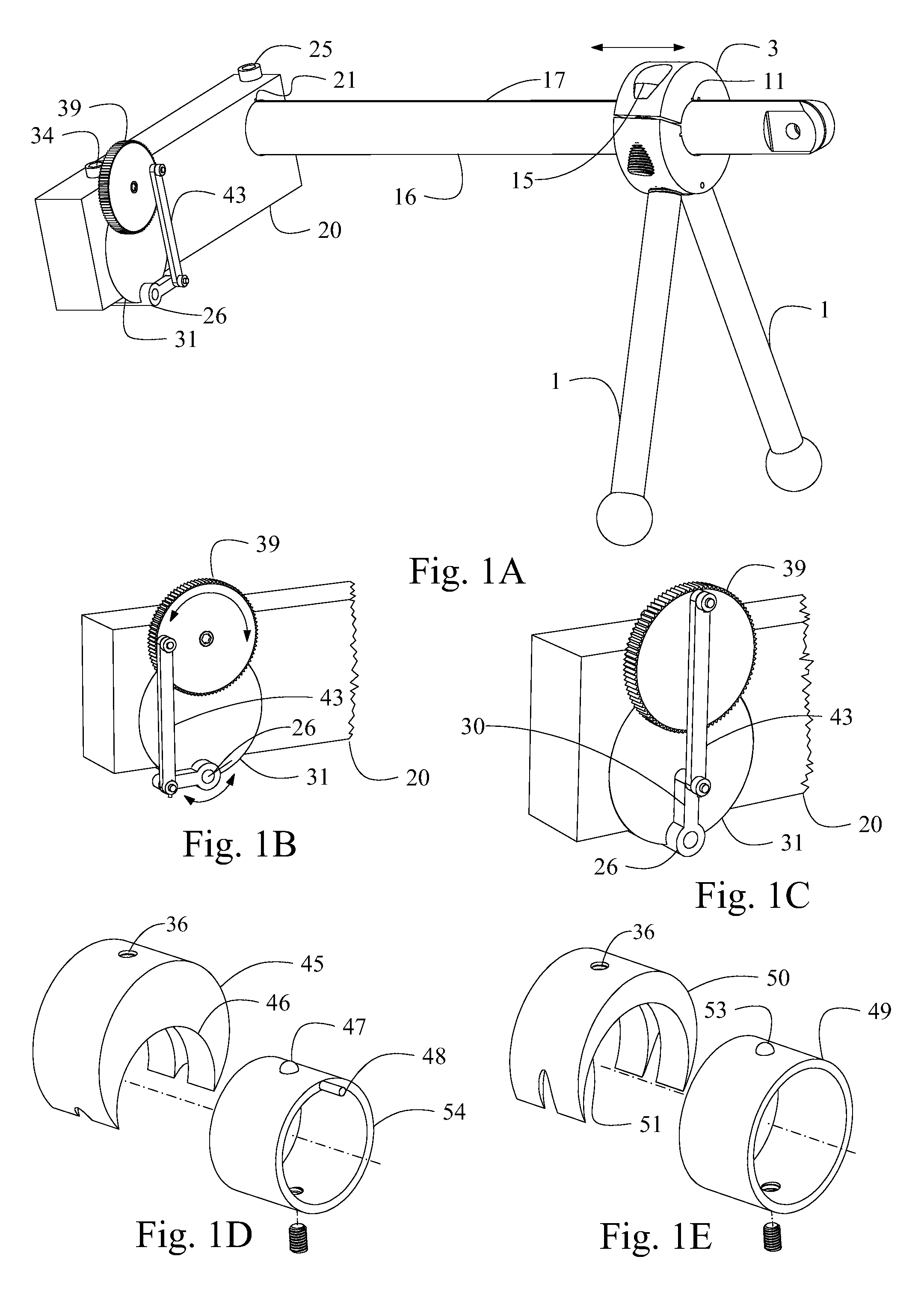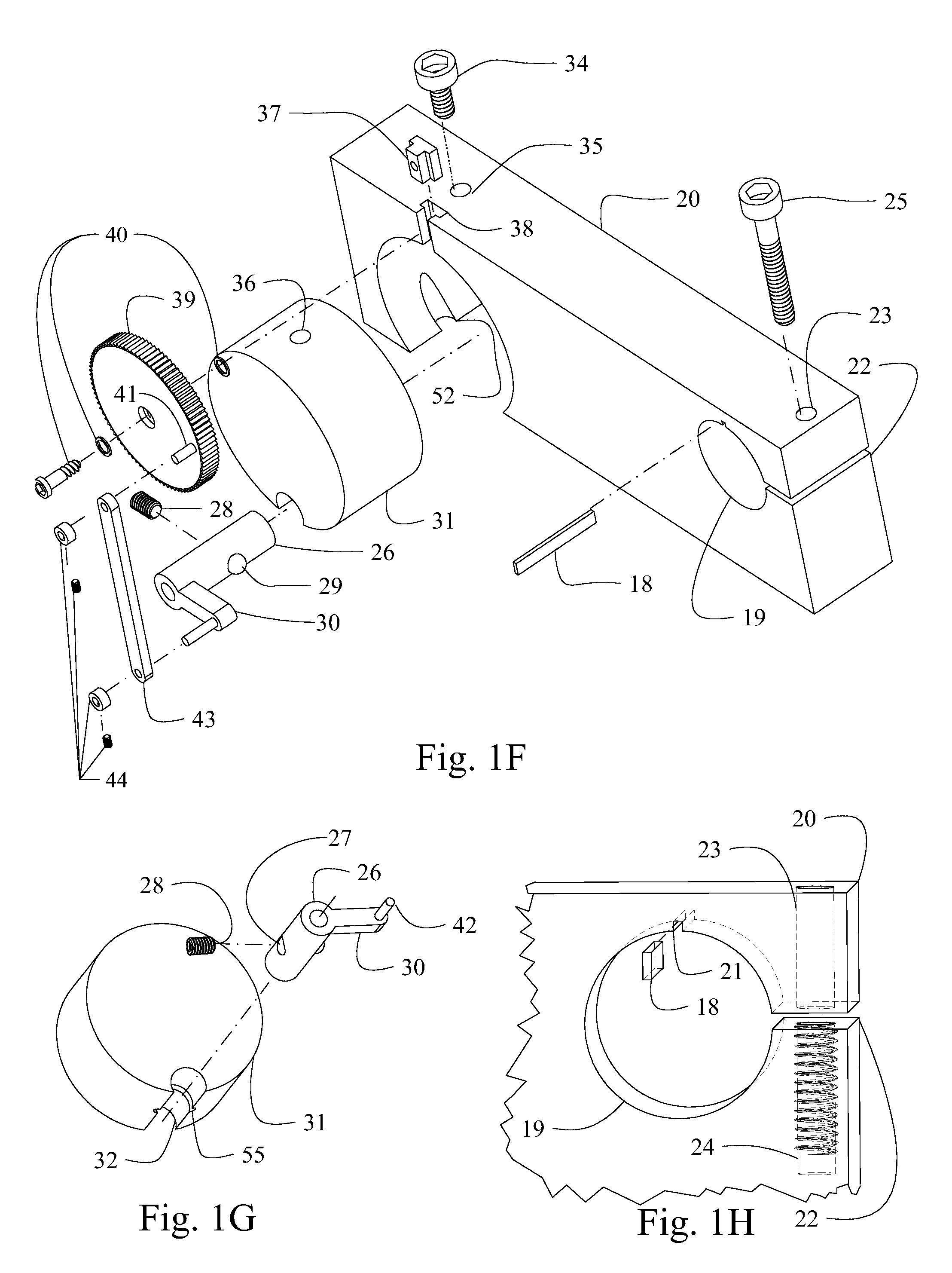A number of problems with these types of honing guides result when an abrading surface is used as a support base for a jig.
With this type of a jig, a tool edge is un able to access the entire surface area of an abrading medium with unrestricted random motion.
This limits a users choices as to sizes of honing stones that can be used with these types of jigs.
Smaller honing stones that a user owns are not useable with these types of honing guides.
Since some areas of an abrading surface are not accessible to a tool edge, un even wear of a honing stone or abrading surface can result.
And since an abrading surface is used as a support base, with long term use, such can cause un wanted wear to a jig.
This design however still requires a significant portion of the surface area of the stone to support the honing guide.
Although a honing stone can be rotated 180° so that both lengthwise edges of the honing stone can have access to a tool edge, a problem still remains for edge tools honed at low bevel angles on narrow stones.
Thus, although the side to side motion, which does have merit with the idea of providing greater access to the surface area of larger stones compared to the then prior art—the problem of providing greater access to the honing stone is still not solved for tools requiring low bevel angles on relatively narrow honing stones.
For some of the narrower honing stones, a tool edge will not be able to reach the edge of the honing stone, since the stone is acting as a support base for the jig.
Another problem that this embodiment brings about, is if the user tends to hone many tools at low bevel angles; depending on the width of the honing stone, only the areas near the edges of a honing stone will come into contact with a tool edge.
Although these types of jigs offer an entire surface area of an abrading surface to a tool edge, a problem the applicant has found with these types of honing guides, is that when a honing stone of a different thickness is swapped in, bevel and
skew angles at a tool edge change due to an abrading height differential.
Base height adjustability was in the original design; however, the Crocker solution does not address the problem of raising the base height of the jig perpendicular or normal to the work surface by the exact amount of a height differential between two abrading surfaces independent of any bevel and
skew angle a tool is set.
Thus, when adjusting the correct bevel angle for one abrading surface, it is not possible to maintain that angle when switching to another abrading surface of a differing thickness.
This causes additional honing time as well as un necessary
tool wear, and thus shorter tool life.
For this very reason, many of the honing guides on the market today for wider tool shanks have been designed such that a base of the honing guide rides on the abrading surface due to the difficulty in creating a
system for vertical base height adjustability independent of bevel and
skew angle settings.
The applicant has found it difficult to hone short shafted, tiny hand
carving gouges used in the wood
cut print making arts, such as Japanese style hand
carving gouges, to a consistent edge.
Tiny western style gouges used in fine detail work are also a challenge to hone a tool edge to a uniform profile.
The prior art is lacking in a universal manual honing solution that can be used on small planar
abrasive surfaces, that can be applied to these tiny gouges, to larger gouges and to wide flat shanked
cutting edges such as plane blades.
This is because it is difficult to find a solution to clamp short tool shanks and present them to an abrading surface at a low bevel angle without a honing guide base bumping in to the edge of a honing stone.
As these smaller tools become shorter with use, it is difficult to hone a uniform edge profile due to less shank length to either hold on to, or clamp into a honing guide.
However, the design requires that a work surface which supports the jig base, be coplanar with the abrading surface at all times. This design does not allow for quick and easy adjustment of the jig base.
Unless one has the equipment such as a power planer to fabricate several work surfaces of differing thickness, or the manual skills to fashion several work surfaces of uniform thickness using hand planes, the jig base will be unable to maintain consistent bevel and skew angles without repeated re adjustment each time a new abrading surface is swapped in.
Although
wet grinding systems are capable of honing a wide variety of tools, such requires expensive motorized equipment and
grinding wheels or
abrasive discs.
The user is thus limited to a
narrow range of
grinding wheels which operate on motorized equipment, and is unable to fully utilize the diverse and wide
ranging types of honing stones and abrasive papers or films available to the
consumer today.
 Login to View More
Login to View More 


